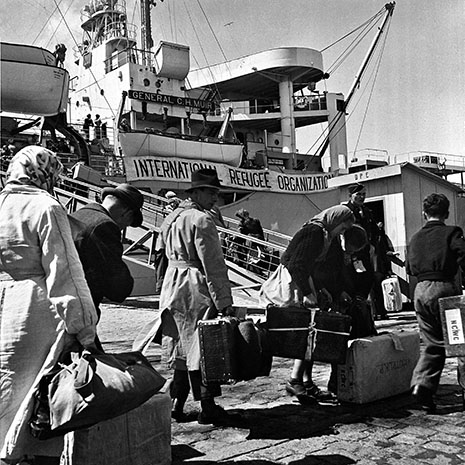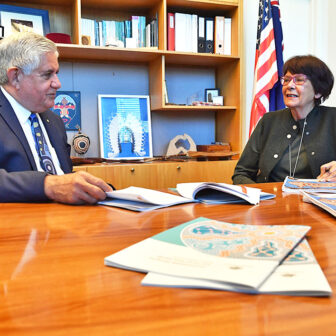Frontier Justice: The Global Refugee Crisis and What to Do about It
By Andy Lamey | University of Queensland Press │ $34.95
THE expert panel appointed by the Gillard government to recommend how Australia should respond to asylum seekers arriving by boat has the unenviable task of finding a solution to a wicked problem. The panel has been asked to report on “how best to prevent asylum seekers risking their lives by travelling to Australia by boat,” and must consider the options in the light of their legislative implementation, Australia’s international obligations, and the costs involved. The panel has been given very little time to evaluate proposals that go beyond the quick fix solutions offered recently in parliament; although it has been asked to make recommendations for the short, medium and long term, the government’s main interest is in finding a way out of the current impasse that would lead to an immediate and dramatic fall in the number of “boat people.”
As I’ve argued previously in Inside Story, parliament’s failure to pass the Migration Legislation Amendment (The Bali Process) Bill 2012, with or without the opposition’s amendments, was a good thing. The Oakeshott Bill, which would have allowed Australia to send asylum seekers either to Malaysia or to Nauru, is no less problematic than the opposition’s favourite option, a revival of the Howard government’s Pacific Solution. The stalemate in parliament since the Senate rejected the Bill at least provides some breathing space to take a broader view of the issues.
Let us assume, for a moment, that there was no sense of panic about “waves” of “illegal” arrivals and no federal election around the corner. In such circumstances, the panel would have the time to draw on historical, international comparative and philosophical perspectives to develop a considered response to its brief.
First, the panel could turn to the past. On at least two occasions, Australia was prominently involved in solving similarly difficult problems created by the forced migration of large numbers of people. In the aftermath of the second world war, more than a million displaced people, unwilling to return to their countries of origin, were stuck in refugee camps in war-ravaged Germany, Austria and Italy. The International Refugee Organization, or IRO, the predecessor of the United Nations High Commissioner for Refugees, facilitated their resettlement. Australia accepted a significant share: between 1947 and 1953, more than 180,000 displaced persons arrived on ships chartered by the IRO. Some thirty years later, Australia was a major contributor to solving the Indochinese refugee crisis, when it accepted a large number of refugees from Vietnam, Laos and Cambodia.
Second, the panel could turn its attention to other attempts to “stop the boats.” An analysis of two such attempts, in particular, would be instructive. In recent years, European Union countries have tried to stem the tide of irregular migration across the Mediterranean. The strengthening of European border control measures has resulted in a decrease in the number of irregular migrants who have been able to reach Europe by sea, and an increase in the number of border-related deaths. The other relevant case concerns the US government’s attempts to prevent Haitians from trying to sail to Florida. The US policies, too, are instructive not so much because they could serve as exemplars, but because of the dire consequences they have had for the kind of people whose lives Canberra politicians would like to save by stopping them from getting onto boats in Indonesia, Malaysia, Sri Lanka or South India.
And finally, the panel could engage with the question of whether Australia ought to stop the boats, regardless of perceived threats to national security or to the social fabric, regardless of international or domestic legal requirements, and regardless of the costs involved.
IF THE expert panellists had more than the next few weeks at their disposal, they could do much worse than to read this new book by Andy Lamey, a philosopher who hails from Canada but now teaches at Monash University in Melbourne. Frontier Justice grew out of a series of radio programs written by Lamey for the Canadian Broadcasting Corporation. This is not a bad thing, even though the fact that individual chapters had their origins as radio documentaries does make the book at times seem disjointed. Because the text was written for a broad audience, and for listeners prone to switch channels or tune out, its narrative is engaging and conversational. This is actually a book that can be read late at night in bed.
Lamey’s starting point is an idea first developed by Hannah Arendt in her 1951 book The Origins of Totalitarianism. Arendt argued that, in the final analysis, human rights alone amount to very little. They are meaningful only if they are propped up by the rights of citizens. As soon as a state takes away a person’s citizenship, and thereby the rights she can claim as a citizen, she is left with nothing. Other states will not recognise her human rights because she lacks the membership that would entitle her to their protection.
Arendt’s pessimism was based on her own experience. When the Nazis came to power in 1933, she fled Germany via Czechoslovakia and Switzerland to France, and in 1941 sought refuge in the United States. For eighteen years, until she became an American citizen, she was stateless, unable to invoke the protection obligations of any government. Lamey concedes that sovereign nation-states are no easy fit for universally recognised and enforceable human rights. But, unlike Arendt, he argues that the rights of non-citizens do not automatically impinge on the sovereignty of the nation-state, and that it is therefore feasible for such rights to be recognised.
Like Arendt, Lamey tries to make his case by focusing on the refugee who is not able to avail herself of the protection of her own government. What happens if she knocks on the doors of another state, asking for that state’s protection? What would need to happen in order to afford her at least some basic human rights without compromising the host state’s sovereignty?
Lamey suggests that Arendt (and other political philosophers, such as Giorgio Agamben, who extended Arendt’s argument) were too categorical in contrasting a state’s sovereignty with a stateless person’s rights. In Lamey’s view, a right to asylum (which was briefly contemplated by the architects of the 1948 Universal Declaration of Human Rights) would indeed undermine the sovereign rights of states. He cites the example of the Federal Republic of Germany, which recognised a right to asylum in its constitution. After the end of the cold war, Germany was inundated by irregular migrants trying to assert their right to asylum, he says, and as a result Germany changed its constitution.
Rather than enshrine the right to asylum in domestic law, Lamey argues that states ought to recognise the right of non-refoulement. Refoulement is a French term used in refugee law to describe an instance where a refugee is returned to the country where she was persecuted. Non-refoulement is one of the key principles of the 1951 Refugee Convention. A person knocking on a country’s door does not have a right to enjoy asylum in that country once her claim to be a refugee has been accepted, and the country whose protection she has sought is entitled to send her elsewhere, but she must not be returned to the place she has fled from.
Lamey names three other entitlements that need to be guaranteed in order to reconcile refugees’ human rights with the sovereignty of nation-states. First, all asylum claimants ought to have the right to an oral hearing. Second, they ought to have the right to be represented by legal counsel. And third, they must not be arbitrarily detained. He calls his model the “portable-procedural approach.”
Arendt’s dim view of human rights for refugees was based on what she witnessed when people fleeing Nazi Germany and territories under its control sought the protection of other countries. Lamey’s optimism is based on his interpretation of Canada’s approach to asylum seekers. He argues that a 1984 decision by the Supreme Court of Canada, in a case involving Sikh asylum seekers whose claims had been summarily rejected, extended the validity of Canada’s Charter of Rights and Freedoms to non-citizens. According to that charter, “Everyone has the right to life, liberty and security of the person and the right not to be deprived thereof except in accordance with the principles of fundamental justice.” According to the judges in what became known as the Singh case, “everyone” meant everyone, citizens and non-citizens alike. “Canada’s precedent is worth stressing,” Lamey writes. “It shows that our civilization can do better than Arendt thought, and far better than is currently the norm.”
In the Singh case, the appellants had sought the right to an oral hearing. In deciding that they were entitled to such a hearing on the grounds of constitutional rights, the court did not endorse a right of refugees to remain in Canada. According to Lamey, “separating the place of recognition from the place of potential enforcement may be Singh’s greatest breakthrough of all.”
In Lamey’s model, states have the right to deny asylum seekers the right to work. They can selectively detain them. They can send them to an appropriate third country. His solution may be a long way from what Hannah Arendt would have considered acceptable, but “if justice for refugees has to wait for a change on the scale of getting rid of national sovereignty,” he says, then “justice will be a long time coming, if it ever comes at all. It is both more realistic, and more radical, to seek justice for refugees in a world of states.”
According to Lamey, neither the opposition’s Pacific Solution nor the government’s Malaysian Solution could be accommodated within the confines of the “portable-procedural approach.” But his model would allow for “transfers to other advanced countries as long as they are done in a rights-based manner.” He cites one such possible transfer, which was mooted in 2007 by the Howard government. Immigration minister Kevin Andrews proposed to swap asylum seekers who had been sent to Nauru for asylum seekers intercepted by the United States in the Caribbean. According to John Howard, the rationale for such an arrangement was to deter asylum seekers from trying to reach Australia by boat: the planned swap was to send “a message that getting to the Australian mainland illegally is not going to happen.” The scheme never got off the ground.
A refugee swap involving Australia and countries such as the United States or New Zealand would be far less problematic than an arrangement whereby Australia sends asylum seekers to countries that are not signatories to the Refugee Convention and other international human rights instruments, or where there are no adequate facilities for processing asylum seekers and asylum seekers don’t have access to legal counsel.
BUT how realistic are Lamey’s proposals? For a start, for his model to work, Australia would need to recognise some basic constitutional rights for non-citizens. That may require the kind of guarantees that only a bill of rights can provide. Australia is one of only a handful of Western countries that does not have such an instrument at the federal level. As Lamey writes, “It is tantalizing to imagine what an example Australia would set to the world were it to become the first country on earth to introduce a bill of rights that included a constitutional right not to asylum but to non-refoulement.”
In the absence of such constitutional guarantees, we can only hope that the High Court follows up its quashing of the Malaysia Solution with other decisions that uphold the rights of non-citizens. The court is currently hearing a case involving a recognised refugee who cannot be released from detention because of an unfavourable ruling by Australia’s domestic intelligence agency, ASIO. It is not inconceivable that the High Court will revisit its 2004 Al-Khateb decision, in which the court decided that the indefinite detention of a non-citizen is lawful. In fact, a Parliamentary Library analysis was already suggesting that Al-Khateb might be overturned soon after the decision.
So it is conceivable that Australia could meet the conditions that would allow for the implementation of Lamey’s “portable-procedural approach.” But that alone would not make such an approach any more realistic, because it would rely on Australia’s being able to identify appropriate third countries willing to accommodate and process asylum seekers who have made it to Australia.
Because it would have nothing to gain from such an arrangement, the most obvious candidate, New Zealand, would probably rule itself out. Others would insist on offloading at least as many asylum seekers as they agreed to take from Australia. But would Australia be willing to ship its asylum seekers to, say, Italy, if Italy could then send part of its caseload to Australia? Such a solution would work only in instances where Australia could call on the solidarity of its friends around the world to relieve it of a comparatively significant burden posed by asylum seekers. As many of its friends in Europe and North America are dealing with far greater numbers of asylum seekers, Australia’s approach could well be ridiculed. In fact, Australia’s failure to find resettlement options for most of the recognised refugees who were stranded on Nauru suggests that it couldn’t count on other nations’ sympathies, in relation either to the number of “boat people” or to Australia’s capacity to accommodate them.
But all that is not to say that Lamey’s suggestions shouldn’t be taken seriously (or that readers ought to rely on my necessarily crude summary of an argument that he develops over the course of 400 pages). And Lamey’s book would make interesting reading for the prime minister’s expert panel for another reason, too. Much of Frontier Justice is an account of the interdiction of Haitian “boat people” by US authorities, their detention at Guantánamo, and the attempts of lawyers to force the US government to recognise their human rights. He shows that Australia could do much better than following once more the offshore processing solution pioneered by the United States.
And seventy-four years after the conference of Evian, which unsuccessfully tried to identify a global solution to deal with those who, like Hannah Arendt, were desperate for a safe refuge, Australia could indeed do much better than to pursue once again a path that prioritises national security concerns and panders to the fears of those who expect to be swamped by a wave of dark-skinned non-Christians without appropriate visas. At Evian, the Australian delegate told the conference that “it will be appreciated that in a young country manpower from the source from which most of its citizens have sprung is preferred, while undue privileges cannot be given to one particular class of non-British subjects without injustice to others.” Justifying Australia’s decision not to increase its intake of Jewish refugees, he also remarked that “as we have no real racial problem, we are not desirous of importing one by encouraging any scheme of large-scale foreign migration.” •




